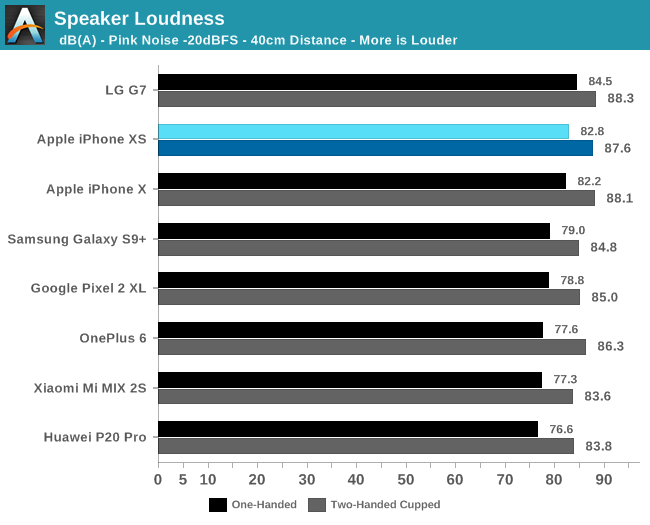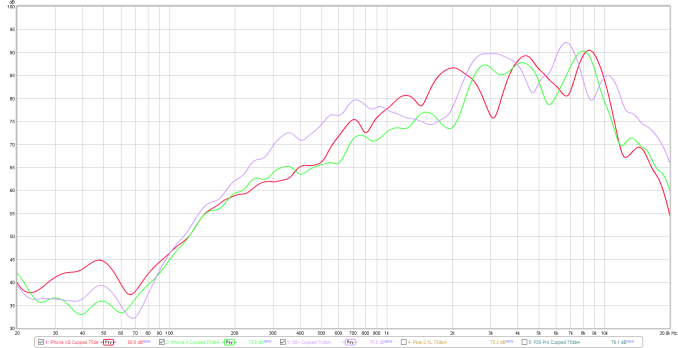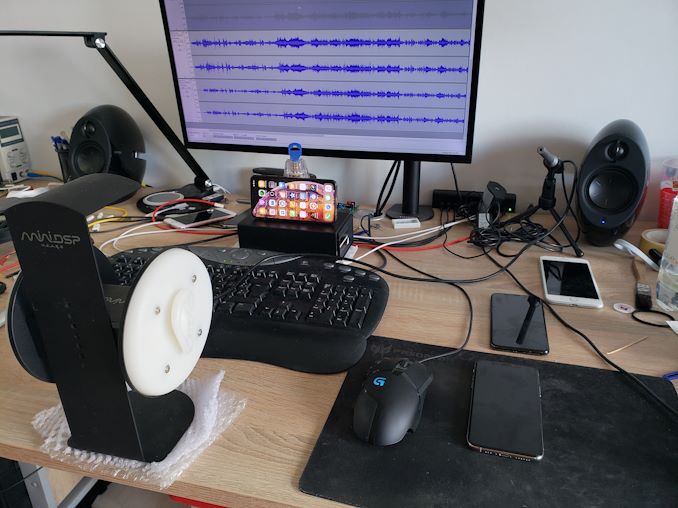The iPhone XS & XS Max Review: Unveiling the Silicon Secrets
by Andrei Frumusanu on October 5, 2018 8:00 AM EST- Posted in
- Mobile
- Apple
- Smartphones
- iPhone XS
- iPhone XS Max
Camera Video Recording
In terms of video recording, the iPhone XS promises an improved dynamic range in modes up to 30fps. What this likely means is that the phone’s able to capture in HDR mode in the 30fps modes, doing the same kind of processing we also see in SmartHDR still pictures.
Also something I’ve dreaded on iPhones for years; the new iPhone XS finally introduces stereo audio recording. Why it took Apple such a long time to finally introduce stereo recording is something that boggles the mind, but, let’s not complain, as we now finally have it on the new generation.
iPhone XS: iPhone X:
Comparing the iPhone XS video to the iPhone X, there’s one thing that is immediately very evident: the new XS is able to produce much better image stabilisation than last year’s flagship. Indeed, it looks like Apple vastly improved the OIS/EIS on the new phones, as the wobble that happens when walking is gone on the XS.
Audio recording finally is up to par, and we can hear the wind and rustling leaves of the trees around us. I think Apple might still have to work a bit on the wind noise cancellation, as in some parts the audio sounded as if it was inside a tube.
In terms of image quality, Apple’s claims of the improved dynamic range are very much verified. The phone showcases a lot more brought down highlights in the scene, and in darker areas, show better shadows. It’s unfortunate that this is limited only to the 30fps modes, but it’s understandable.
Switching over from the main lens to the telephoto lens happens relatively fast, although with a short exposure flash and a slight delay on the first zoom. 4K60 recording doesn’t allow for the use of the telephoto lens.
All in all, the video recording quality of the new iPhone XS is massively improved in all areas of stabilisation, picture quality, and audio. 4K30 recording on the XS is probably the best I’ve seen on any smartphone – a definitive applause to Apple for the improvements here.
Speaker Evaluation
Apple claimed to have improved the speaker audio quality on the new iPhone XS, allowing for more stereo separation and filling sound. I had introduced a new speaker evaluation method a few months ago because this year’s efforts by smartphone vendors to improve speaker quality has been very pronounced, and I wanted to have a way to objectively convey these improvements.
Starting off with speaker loudness, we’re measuring the phones at maximum volume, both in one-hand portrait mode, as well as two-handed mode where the palms are cupped towards the user. These two use-cases are what I find myself most often using the phone’s speakers in, so hopefully that also represents how most users use it as well, please let me know otherwise!

Using a pink noise signal, the iPhone XS pretty much falls into line with the results of the iPhone X, coming in at a very loud 82.8dBA in portrait mode and 87.6dbA in two-handed mode. Apple’s sound directionality on the iPhone X and XS is among the best, most likely due to the fact that the stereo earpiece is among the loudest of current generation smartphones.
Measuring the frequency response of the speakers, we see the iPhone XS closely following the measurement of the iPhone X, however there’s a major difference in the mid-range where the XS is around 5dB louder, raising instrumental frequencies and voices. This difference is what I think Apple is referring to when talking about better “fullness”, as it is evident when playing back media.
To better demonstrate the difference between the phones, I’ve attempted to capture them with a binaural microphone setup. Now I know my environment isn’t perfect as I don’t have the necessary sound dampening equipment, but I hope it does serve as an overall adequate A/B comparison between the phones. I’ve tried to calibrate the sound as much as possible recorded by the setup to a flat frequency response, although I’m sure there are improvements to be made. As a comparison, I also included calibrated speakers as a baseline to get an idea of the microphone setup.
The audio is meant to be listened to with headphones, or even better with IEMs, as this will give the intended playback of the binaural recording.
The iPhone XS’ improvements in the mid-range are quite evident as voices sound deeper and more pronounced on the new phone. Stereo separation is also quite good – resulting in a filling audio experience.
I included the S9+ and G7 as comparison devices. Samsung still does a significantly better job at the low-mid ranges which gives the phone more overall presence than the iPhones, also has an advantage in the very high frequencies giving more clarity, however the new iPhone’s XS strength point in the mid-ranges is the S9’s weakness, and vocals sound a lot less present than on the XS.
As for the G7, I just wanted to showcase a mono speaker device, and just how huge the audio difference is. Unfortunately the G7, even though it promises to have a good speaker, fails in practice.












253 Comments
View All Comments
name99 - Friday, October 5, 2018 - link
"I do hope Samsung and Apple alike would be able to focus more on optimising this, as like we’re about to see, it will have an impact on battery life."Presumably Apple's longer term plan (next year?) is to move to the LTPO technology in the aWatch4 display?
https://appleinsider.com/articles/18/08/24/future-...
https://www.reddit.com/r/apple/comments/9ga4wa/dis...
This appears to be an Apple specific (ie non-Samsung) tech, though who knows exactly what the web of patents and manufacturing agreements ultimately specifies...
SanX - Friday, October 5, 2018 - link
Similar to mobile processors performance surpassing some desktop ones, the mobile devices image quality also surpassing 5-7 years old DSLR tech. Your photo test suite would be great if it adds the Still Life, Resolution and Portrait tests from the pro photo testing sites like Imaging-resource dot com. I'd just send the phones to these folks and they do their tests so we would see the progress in comparison with all cameras of all times and manufacturers. Right now only the fields tests of Anandtech look poor and are not enough to tell what is good and what is missing in the cameras. Due to the great progress, the time for such new deep testing of mobile devices came right now.Pneumothorax - Sunday, October 7, 2018 - link
No way my Xs Max is touching my 10 year old D700 with a cheap $100 50 1.8 lens in anything over base iso. The iPhone starts applying some serious noise reduction at higher ISO’s making it watercolor like. Even at base iso, the D700 has much better fine detail.Constructor - Sunday, October 7, 2018 - link
Not to dispute your fundamental point (bigger lenses and bigger sensors can't really be replaced), but there are several low-light photo apps for the iPhone which support much longer exposure than the standard one and this can of course help at least with static images when you've got a fixed position for the iPhone.yvn - Friday, October 5, 2018 - link
I was surprised you said excellent viewing angle, I disagree! If you tilt the screen just a little up or down, left or right, the color changes a lot, it becomes more blue as you tilt more and I couldn’t get used to this so I returned the phone, my iPhone 7 Plus had no such behavior.Notmyusualid - Friday, October 5, 2018 - link
So... dual-sim finally (only phone type I buy), 4x4 MIMO, 7nm, but still no Android?!?Would it KILL Apple to offer an Android version, I mean really, would it? Even Sony broke in the end...
Guess they don't need my money, but nice handset, if a bit pricey.
cfenton - Saturday, October 6, 2018 - link
I can't tell if this is a serious comment. Apple makes something like 85% of the profit in the mobile phone market. They have absolutely no reason to even consider putting out an Android phone.Speedfriend - Tuesday, October 9, 2018 - link
Oh, that rubbish stat again. That is only in the narrowly defined mobile market. Apple makes its own OS, designs many of its own chips and controllers, sells its own insurance, runs its own app store and its own retail shops. It has many more parts of the overall value chain. For an accurate comparison, we would need to include what Qualcomm and Samsung make from SOCs, what Samsung and LG make from screens, what Samsung makes from memory etc.varase - Tuesday, October 23, 2018 - link
What, you kidding?I'm sure one reason for the push into custom silicon was because it was one thing Android OEMs couldn't copy.
Hifihedgehog - Saturday, October 6, 2018 - link
I am a little confused here by your rather bold assertion of desktop-class performance. Correct me if I am wrong, but aren’t the test results here for SPECint2006 inclusive of all cores whereas the Intel processor’s score you linked to is for a single thread. If so, then comparing six cores versus a single thread in a multithreaded desktop CPU is not very fair or valid. Again, I could be totally wrong but I just wanted to point this out.